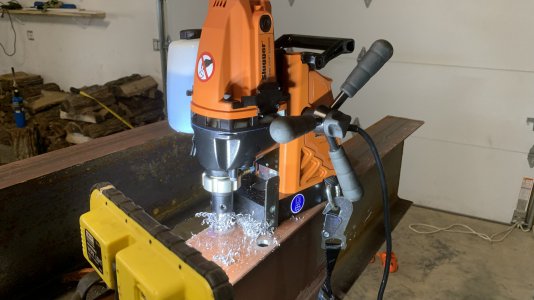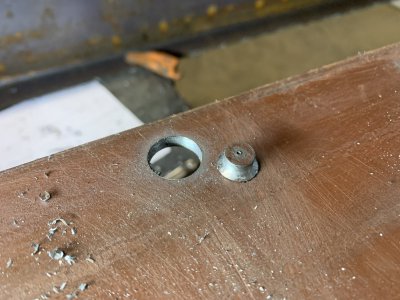-
Welcome back Guest! Did you know you can mentor other members here at H-M? If not, please check out our Relaunch of Hobby Machinist Mentoring Program!
You are using an out of date browser. It may not display this or other websites correctly.
You should upgrade or use an alternative browser.
You should upgrade or use an alternative browser.
Bridge Crane build
- Thread starter rabler
- Start date
- Joined
- Feb 25, 2021
- Messages
- 3,146
Picking one out is on this week’s to-do list. I’m spending the week doing my biannual medical trip so some online shopping and reading reviews will be a good distractionDo you have a mag drill? Seems like you would need one to make life easier.
- Joined
- Feb 25, 2021
- Messages
- 3,146
I’m using an underslung trolley so that won’t work for the bridge in my application.Another approach is to put thick steel cables along the bottom web, with a spacer to offset them, and making a shallow vee. With preload it can increase the load capacity by as much as 10-12%
- Joined
- Dec 20, 2021
- Messages
- 894
I ended up with L/1000 on a 24ft span. That was driven by stresses in the flanges and a good safety factor. Looking at different documentation for crane design, L/1000 is the stiffest design I've seen so far. If L/2000 would have been realistic, I'd probably have gone that route...I use the formulas to calculate deflection and stress for the beam Im dealing with. again its a while ago but using that criteria I think my bridge beam would be in the range of L/1200 ie 1/8th of an inch on the 12 foot span.
Greg
I have seen some crane designs that use reinforced flanges near mid span (Maybe 1/3 to 1/2 span) with a 1/2 plate welded top and bottom flanges. Makes sense since bending moment and peak stresses are mid span. However, I didn't want to get into the design of adding extra steel to a W beam and making sure it was welded properly. Lot easier to calculate loading with uniform shapes and just buying that shape...
Even then, steel cost was nothing to scoff at. But as they say, I ain't getting any younger, so I'm sure in 10 or 20 years I'll appreciate it even more.
- Joined
- Feb 25, 2021
- Messages
- 3,146
In a similar mindset to @dkemppai , designing a more complex structure may mean a lighter structure rather than just heavier beams, but that becomes a more complicated design, and harder to build, more failure mechanism, more chance for mistakes.
My design goals were to maximize the lift height, and other than the chainfall, keep everything above 10’. My shop layout means going under one ofthe side rails to get into that part of the shop.
My design goals were to maximize the lift height, and other than the chainfall, keep everything above 10’. My shop layout means going under one ofthe side rails to get into that part of the shop.
- Joined
- Oct 11, 2016
- Messages
- 3,871
I have a few inches short of 8 feet to work with and I'm losing another 4 inches for the bridge tracks. so my primary goal was compactness. I'll post pictures. in the new thread under projects.keep everything above 10’.
- Joined
- Feb 25, 2021
- Messages
- 3,146
My tractor rollbar sits about 98” high, it won’t clear 8’. And since it is behind the driver, it is invisible in normal operation. I have learned to be sure doors are up all the way as it is easy to foget that rollbar. I’m using a 10’ high door, so 10’ rail clearance guarantees if it fits in the door it will fit under the rail.I have a few inches short of 8 feet to work with and I'm losing another 4 inches for the bridge tracks. so my primary goal was compactness. I'll post pictures. in the new thread under projects.
- Joined
- Feb 25, 2021
- Messages
- 3,146
As I mentioned to @woodchucker above, I purchased a mag drill to drill the beams. At 40 ft long, no way to maneuver them into a drill press 
First time I've used a mag drill or annular cutters. This certainly made easy work of drilling these 11/16" holes. One lesson I quickly learned, pecking with annular cutters doesn't work, as the chips lodge under the cutter in the circular grove. Better to just keep drilling steadily.
The mag drill, a Fein JHM shortslugger, has a small tank on the far side with a coolant feed down the inside of the cutter. A spring loaded pin, sort of like a tap follower, helps center the cutter. This drill has a "safety" feature that doesn't allow the motor to be turned on unless it is on at least 3/8" plate. These beams were not of sufficient thickness (W10x12), although the magnet held well enough. They include a jumper that you can place on the internal circuit board to bypass this safety feature. Would seem to me that a lower threshold would make more sense, as the safety feature would shut the drill off if it comes off the beam. Makes me wonder if it is more of a feature meant to reduce their liability?


First time I've used a mag drill or annular cutters. This certainly made easy work of drilling these 11/16" holes. One lesson I quickly learned, pecking with annular cutters doesn't work, as the chips lodge under the cutter in the circular grove. Better to just keep drilling steadily.
The mag drill, a Fein JHM shortslugger, has a small tank on the far side with a coolant feed down the inside of the cutter. A spring loaded pin, sort of like a tap follower, helps center the cutter. This drill has a "safety" feature that doesn't allow the motor to be turned on unless it is on at least 3/8" plate. These beams were not of sufficient thickness (W10x12), although the magnet held well enough. They include a jumper that you can place on the internal circuit board to bypass this safety feature. Would seem to me that a lower threshold would make more sense, as the safety feature would shut the drill off if it comes off the beam. Makes me wonder if it is more of a feature meant to reduce their liability?


- Joined
- Oct 11, 2016
- Messages
- 3,871
My Milwaukee has the same 'feature'. It stops a guy from 'gronking' on the handle and pusing so hard the drill dislodges and falls on someone's head (below)....This drill has a "safety" feature that doesn't allow the motor to be turned on unless it is on at least 3/8" plate.
My circuit died and it is 300$ to replace. Will be bypassing the circuit when or weather improves (minus 18 C today) i guess that's 0.0 F-ish...

